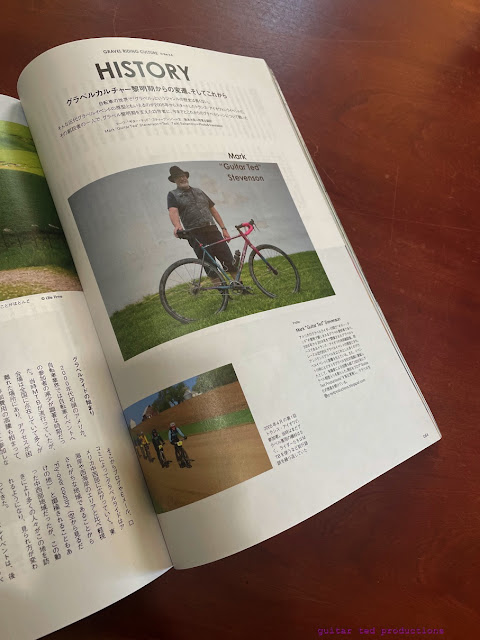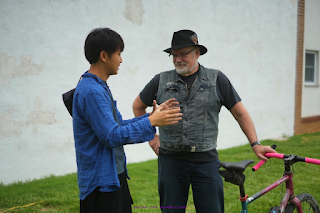 |
| My article appeared in this issue of Bicycle Club recently |
Sakamoto-San asked me to write a four page article detailing my take on those subjects. He told me that he wanted to show his audience that gravel cycling was more than competition. Sakamoto-San promised that he would send me a copy of the magazine the article appeared in when it published. That has happened and I now have the magazine (actually, he sent me three magazines!), and I thought that it would make for a good story here, as far as how this all went down.
First of all, the entirety of what I wrote to Sakamoto-San can be seen in my post from early July HERE. While not all of that was used, a majority of it was, and I am forever grateful and honored that Sakamoto-San and his magazine crew found it worthy of putting in front of their Japanese audience.
 |
| Sakamoto-San and Guitar Ted Image taken by Otaki-San |
I've told this story before here, but it bears upon this experience, so I will risk a brief retelling here. Once during a Frostbike weekend at QBP where I was shadowing Jason Boucher, then of Salsa Cycles, I was found watching Jason clearing up his cubicle space. Jason was telling me that he had to meet with some of Salsa Cycles' Japanese distributors. He expressed his admiration for them, but couched that with his dismay concerning how long it took to wait for the Japanese folks to take imagery. "Mark, they take pictures of everything!", he told me as he stuck smaller objects and papers in drawers that he did not want seen in public.
I pressed into that a little bit and Jason explained that, for whatever reasons, (and I am going off decade+ memories here) the Japanese find that your objects and surroundings speak to who you are as a person, so they want to capture as much of this as possible. If I got that wrong, please somebody correct me in the comments, but that was my memory of the moment.
So, when Sakamoto-San and his two friends showed up on the streets of Emporia looking for me, I noted that all three had massive, expensive digital cameras and some serious looking glass attached to them. I was quickly reminded of what Jason had said and I was ready for lots of picture taking.
 |
| The article as it appears in "Bicycle Club" issue #457. |
 |
| Image taken by Otaki-San |
Sakamoto-San even wanted to have images taken showing he and I in mock conversation. While Sakamoto-San is not fluent in English, he had enough of a command of it that I could make out his meanings. I think he was afraid the conversation between us would be impossible, so he suggested through his friend, who did interpreting for us, that we should stage the conversation.
I had other ideas, and pressed into conversation with Sakamoto-San anyway, and we ended up having genuine discourse, which was pleasant. You can see in the image there where Sakamoto-San is describing something to me and this was at the point where we were engaging each other and having a genuine conversation. I really enjoyed meeting him and his friends also.
Of course, I went home, wrote what I wrote (linked above) and sent it off with no expectations of anything. However; last week a package showed up in the mail from Japan. It was three copies of issue #457 of "Bicycle Club". I was immediately struck by a few things I'll share here. This may be a well known thing to some of you dear readers, but for me, this was a learning experience.
 |
| I cut out and saved the stamp. |
First thing I noted was how the magazine was formatted. The binding was on the right side as you look at the front cover. So, in our Western way of doing things, this appears backward. The next thing you might note is the Japanese language, in this case, is written in columns. The format is called tategaki. The reader reads down the first column which is furthest to the right then when they reach the bottom they continue at the top of the next column to the left.
Curiously the image captions seem to be written in the yokogaki format and this would mean the characters are read left to right, as in English. I could be wrong about this, so if anyone reading is knowledgeable on Japanese magazine style, please correct me in the comments.
My piece in the magazine was edited somewhat, but Sakamoto-San sent me his translation beforehand to approve, so I knew what would be going into the article. On the whole, it represents the article I wrote well enough and it seems to have connected with the audience from what Sakamoto-San has shared with me. He tells me via Messenger, "It was truly an honor to talk to you. Since the magazine was released, I have received the following comments: "I'm so glad you were able to cover such a valuable story about the early days of gravel!" "How did you meet Mark?" It was all made possible thanks to Mark's help! Thank you so much!"
So, I guess it was a successful effort. I was gifted the opportunity to speak to an audience which I would not have had the chance to speak to without Sakamoto-San's invitation. For this I am very grateful. I am curious, of course, about how this article was interpreted by their audience and if it makes an impact on riding in Japan. Perhaps I'll never know, but I see it as an honor to have had the stage to speak from, thanks to Sakamoto-San. Plus I was able to get to know Sakamoto-San a little bit, which was great. Through the whole process of this article and meeting he was extremely kind and gracious. The experience was really good.
Thanks for reading Guitar Ted Productions

No comments:
Post a Comment